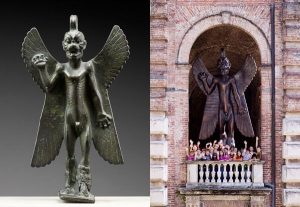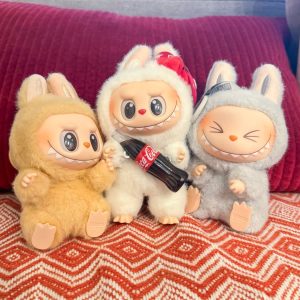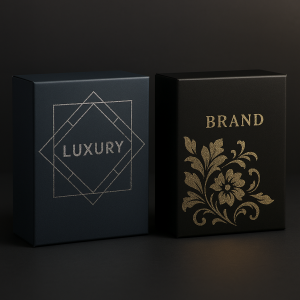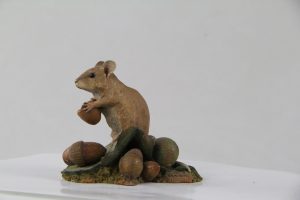create the best resin crafts for the world buyers
xmreefone
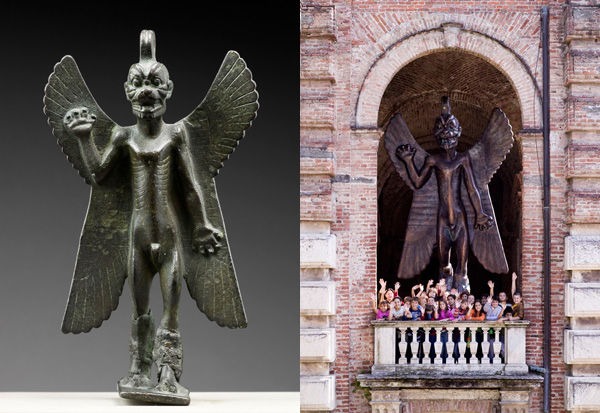

In today’s dynamic collectibles market, a manufacturer’s ability to reproduce both contemporary designer toys and historically significant icons speaks volumes about its technical versatility and creative acumen. Our factory, with over twenty years of dedicated experience in sculpting, molding, and finishing resin art pieces, has successfully produced two remarkably different figures:
Labubu, the “ugly-cute” rabbit character beloved by modern toy collectors, and Pazuzu, the fearsome winged demon of ancient Mesopotamian religion. Though they occupy opposite ends of the cultural and aesthetic spectrum, these two figures share one thing in common: they demand an exacting level of precision and artistry that only a seasoned resin crafts team can deliver.

In this essay, we will explore the origins, cultural significance, design and production challenges, and market potential of Labubu and Pazuzu—demonstrating how our capabilities enable clients to tap into disparate yet equally compelling worlds of imagination and history.
Labubu: The “Ugly-Cute” Innovation in Designer Toys
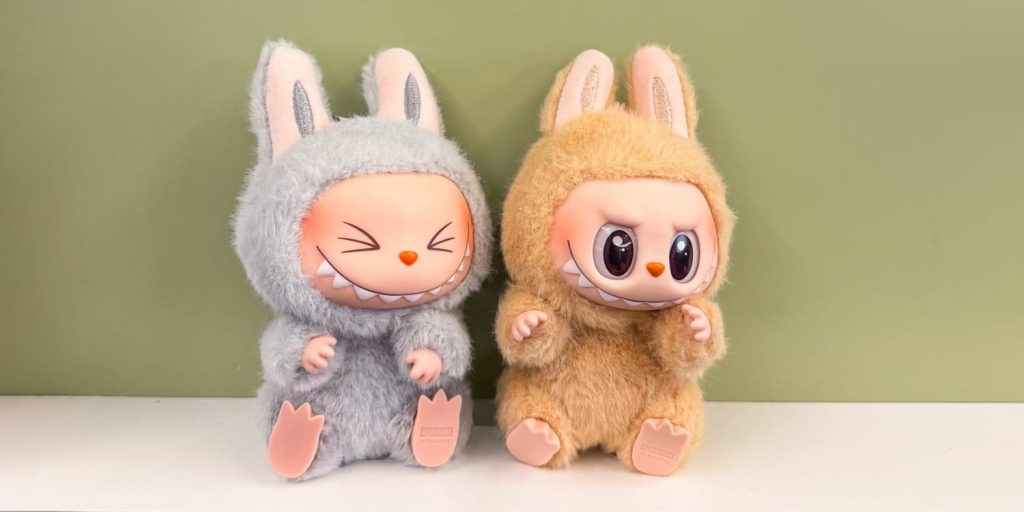
1.1 Origin and Brand Collaboration
Labubu first emerged in 2018 as part of a collaboration between the Taiwanese collective Labubu Project and the trend-setting blind-box giant Pop Mart. Conceived as an antithesis to overly polished, mainstream “cute” characters, Labubu’s design leans into deliberate asymmetry and a slightly unsettling yet endearing expression. Its oversized head, stubby limbs, and minimal facial features are painted in soft pastels—creating a juxtaposition of approachable color with an unconventional silhouette.
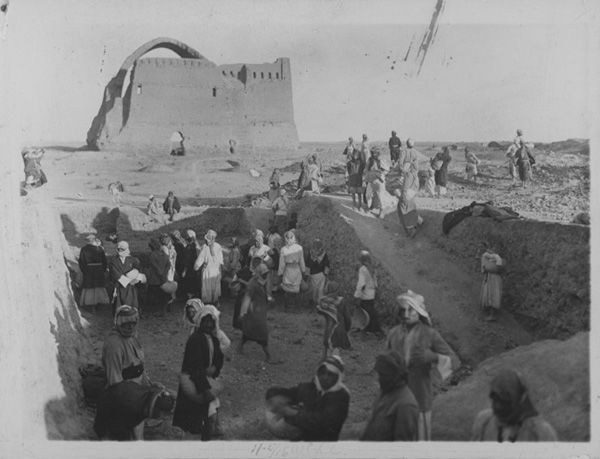
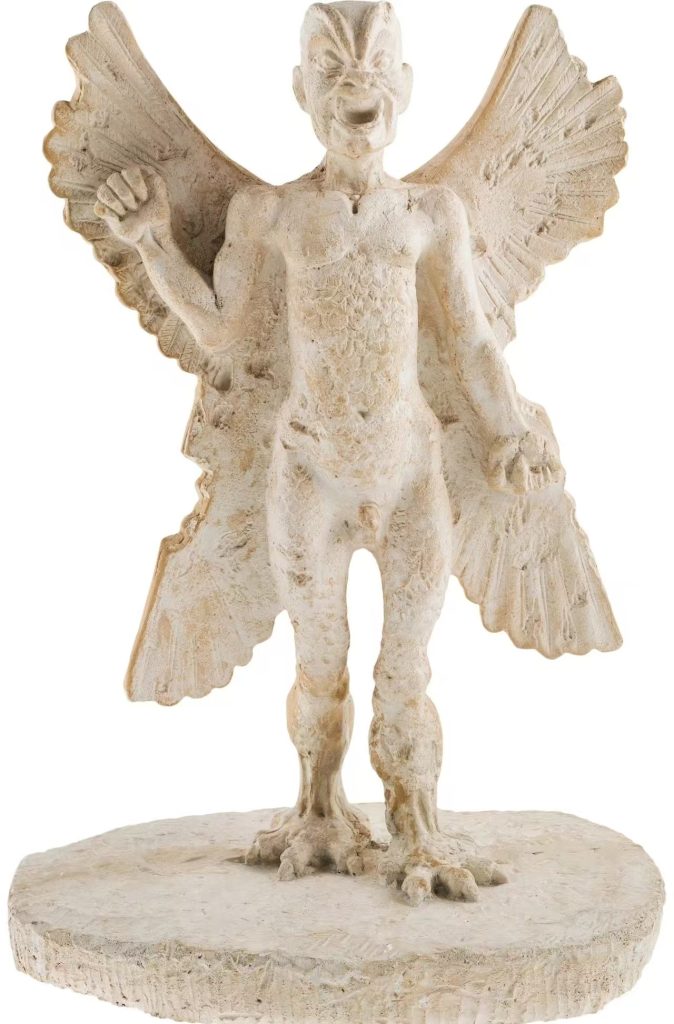
1.2 Aesthetic Appeal and Collector Psychology
The appeal of Labubu lies in its sophisticated balance of charm and oddity. In the fast-growing blind-box market, consumers seek not only surprise but also collectibility. Each Labubu figure comes in a sealed package, and the thrill of unboxing plays into the psychology of scarcity and rarity. Limited-edition colorways and seasonal variants further fuel demand, encouraging repeat purchases among collectors eager to complete their sets. Social-media engagement—driven by the “reveal” videos and user-generated photos—amplifies brand visibility, making Labubu a viral sensation in key markets across Asia, North America, and Europe.
1.3 Production Requirements and Quality Control
Recreating Labubu’s smooth contours and precise color schemes in resin requires meticulous mold design and rigorous color-matching protocols. Our process consists of:
- 3D CAD Modeling and Prototype Sculpting: Translating 2D concept art into a 3D digital model, then hand-refining with clay to perfect proportions.
- Silicone Mold Making: Crafting multi-part silicone molds that capture every subtle curvature and detail without undercuts or flash.
- Resin Casting and Demolding: Using high-strength polyurethane resin for durability, then carefully demolding to preserve surface integrity.
- Painting and Assembly: Employing automated Pantone-compliant spraying for base colors, followed by skilled hand-painting for features like eyes and blush.
- Quality Inspection: Each figure undergoes a ten-point inspection—checking color consistency, mold lines, paint precision, and overall finish—to ensure a flawless, Instagram-worthy product.
Pazuzu: Reviving an Icon of Ancient Mesopotamia
2.1 Mythological and Ritual Context
In stark contrast to Labubu’s playful aura, Pazuzu originates from the ancient civilizations of Sumer, Akkad, Babylonia, and Assyria (circa 1000–600 BCE). Known as the “king of the wind demons,” Pazuzu was invoked both to inflict and to repel malevolent forces, particularly those associated with the southwest wind, famine, and disease. Paradoxically, while feared for his destructive power, Pazuzu also served as a guardian against the evil goddess Lamashtu, who preyed upon pregnant women and infants. Artifacts—ranging from small amulets worn at the neck to larger temple reliefs—attest to his dual role in Mesopotamian spiritual life.
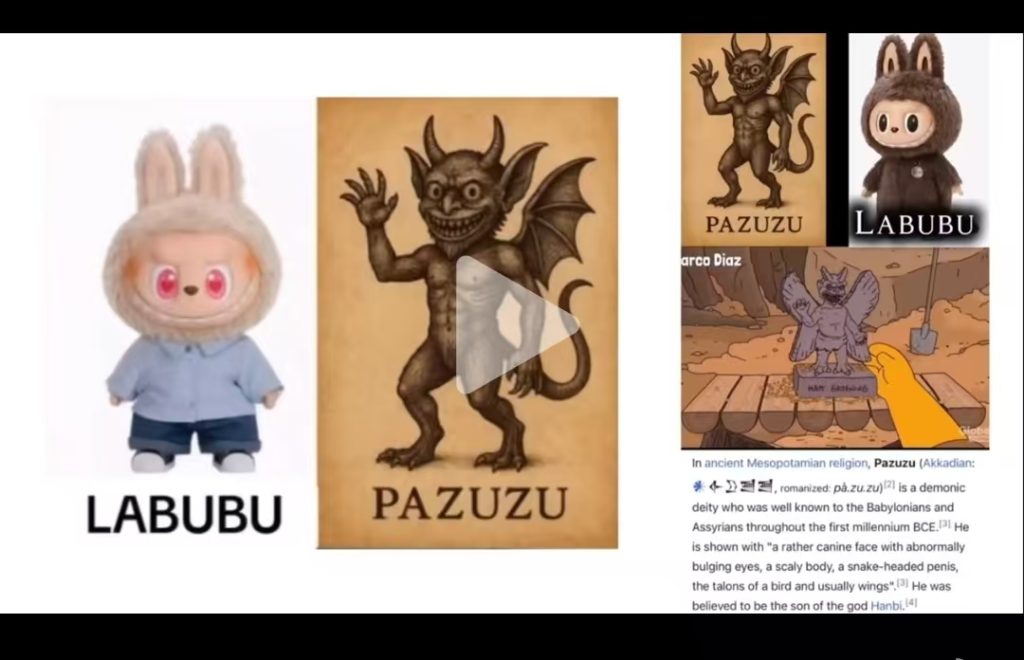
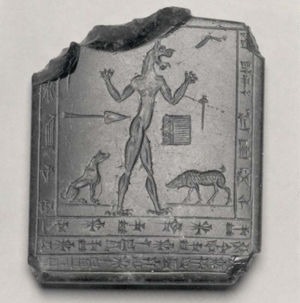
2.2 Iconography and Symbolism
Pazuzu’s iconography is unmistakable: a canine-like face with bulging eyes and bared fangs; a scaly, sinewy torso; wings resembling those of an eagle or vulture; and a tail that often terminates in a snake-headed phallus—symbolic of both virility and potential danger. Each anatomical element conveys a specific protective or threatening attribute. For example, the wings channel the demon’s dominion over wind and storms, while the serpent motif underscores transformative, regenerative power. Our ability to reproduce such intricate symbolism in resin form hinges on deep research and precise sculptural technique.
2.3 Production Workflow for Historical Replicas
Producing a museum-quality Pazuzu statue involves distinct steps beyond those used for designer toys:
- Scholarly Research and Reference Gathering: Collaborating with archaeologists and referencing peer-reviewed publications, museum catalogs, and high-resolution photographs of extant amulets, relief panels, and statuary.
- Detailed Sculpting and Relief Work: Hand-carving the figure in clay to ensure that textures—such as feather patterns, muscle striations, and serpent scales—faithfully replicate the ancient originals.
- Master Mold Fabrication: Generating a high-fidelity silicone master mold, capable of capturing sub-millimeter details without deformation.
- Resin Composition and Additives: Selecting a resin blend that mimics stone density, often with mineral fillers to achieve a matte, sandstone-like finish.
- Finishing and Antiquing: Applying layered patinas—using washes of diluted pigments—to simulate age, weathering, and the subtle color variations found in archaeological relics.
Cultural Implications and Market Positioning
3.1 Divergent Consumer Audiences
- Labubu Collectors: Predominantly young adults aged 18–35 with disposable income, active on platforms such as Instagram, TikTok, and collector forums (e.g., Reddit’s r/vinyltoys). They prize novelty, design innovation, and community validation.
- Pazuzu Enthusiasts: Academic institutions, museums, history buffs, and specialty retailers of antiquities replicas. These clients demand authenticity, contextual accuracy, and educational value as much as aesthetic merit.
3.2 Price Point and Packaging Strategy
- Labubu figures, produced in high volume, are typically priced in the USD 20–50 range per blind box, with premium editions commanding higher prices among secondary-market resellers. Packaging emphasizes vibrant graphics, on-brand logos, and protective blister trays.
- Pazuzu replicas, by contrast, are positioned as premium collectibles (USD 200–600), often sold with a certificate of authenticity, explanatory booklet on Mesopotamian mythology, and custom-printed gift box reminiscent of museum gift-shop packaging.
3.3 Promotional Channels and B2B Outreach
For both Labubu and Pazuzu, our marketing strategy leverages targeted B2B channels:
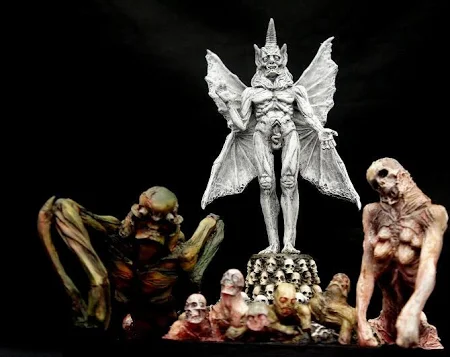
Trade Shows: Participation in events such as Hong Kong Toys & Games Fair (for designer toys) and International Council of Museums (ICOM) conferences (for historical replicas).
Distributor Partnerships: Collaborating with blind-box distributors and museum-gift suppliers, offering tiered pricing, exclusivity agreements, and co-branded promotional campaigns.
Digital Catalogs and Sampling Programs: Maintaining an online portfolio with 3D product renders, detailed spec sheets, and sample-order incentives for qualified accounts.
Technical Challenges and Quality Assurance
4.1 Precision vs. Scalability
Balancing the fine detail required for Pazuzu’s wings and musculature with the need for efficient, scalable production is a key challenge. We address this by:
- Investing in high-precision CNC milling to produce master molds that capture nuanced textures.
- Employing in-line mold-temperature control systems to minimize dimensional variance across batches.
4.2 Color Consistency and Finish Variability
Whereas Labubu demands spot-on Pantone color matching across thousands of units, Pazuzu’s antiqued patina calls for skilled hand-finishing. Our approach:
- Automated Spray Booths for base-coat consistency on designer toys.
- Artisan Station Workflows for patina application, where experienced finishers apply washes and dry-brushing to emulate aged stone.
4.3 Environmental and Safety Standards
Both product lines comply with international regulations:
- RoHS (Restriction of Hazardous Substances) for chemical safety.
- ASTM F963 for toy safety regarding small parts and sharp edges.
- REACH compliance for materials imported into the European Union.
Case Studies: From Prototype to Full Production
5.1 Labubu “Pastel Bunny” Edition
- Timeline: Concept to bulk shipment in 12 weeks.
- Volume: 50,000 units across five color variants.
- Outcome: Sold out in two days on Pop Mart’s online platform, with resale prices averaging 2× the retail price.
5.2 Pazuzu “Guardian Demon” Replica
- Timeline: Six-month development cycle, including academic review.
- Volume: Limited run of 500 units, each individually numbered.
- Outcome: Adopted by a major European museum gift shop as an exclusive souvenir, with an average sale price of USD 350.
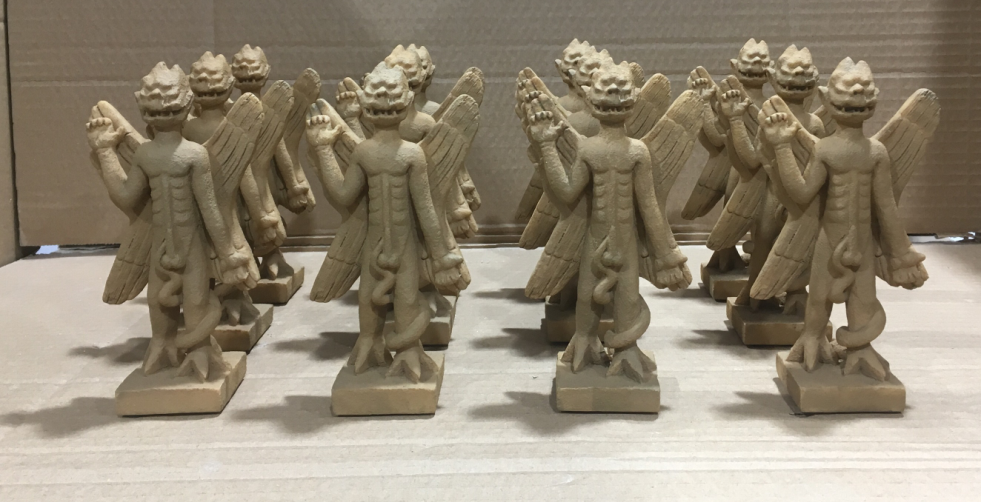
Conclusion and Future Directions
Our successful production of both Labubu and Pazuzu statues underscores our factory’s rare combination of creative flexibility, technical expertise, and deep respect for cultural context. By mastering workflows that range from high-speed blind-box toy manufacturing to painstaking archaeological replica reproduction, we enable brands and institutions to realize ambitious product visions—whether the goal is tapping into today’s vibrant designer-toy market or bringing ancient mythology to life in museum-grade collectibles.
Looking forward, we continue to invest in advanced materials research (e.g., bio-resins, conductive finishes), digital sculpting technologies (e.g., VR-assisted modeling), and sustainable production practices. These innovations position us to partner with visionary clients seeking to push the boundaries of collectible design—blurring the lines between pop-culture whimsy and historical reverence, much like Labubu and Pazuzu themselves.
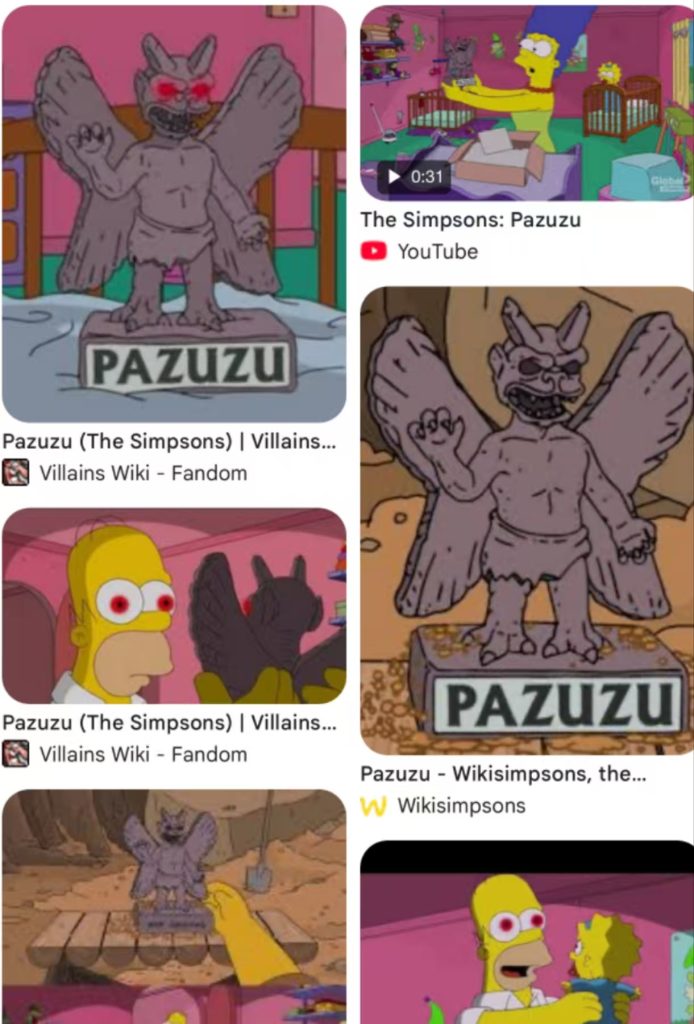
With two decades of sculpting pedigree, proprietary mold-making processes, and a global logistics network, we stand ready to collaborate on your next groundbreaking project. Whether you envision a character that sparks social-media frenzy or a relic that educates and inspires, our team will deliver a finished product that meets the highest standards of artistry, quality, and market appeal.

